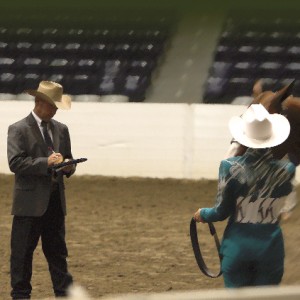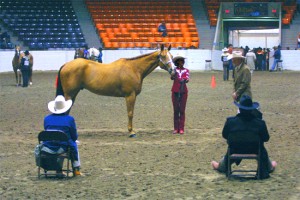Showing It Off – Polishing Showmanship Skills
Click here to read the complete article
By Chris Crumpler
 Showmanship, as defined by Webster, is the art of performing an artistic style of presentation. The term stems from magicians and the craft they use to astound audiences. A good way to look at showmanship is to see it as a type of presentation. Remember being in school and having to give a presentation or a speech? You weren’t aware of it at the time, but show-and-tell in kindergarten was the first time you flexed your showmanship skills.
Showmanship, as defined by Webster, is the art of performing an artistic style of presentation. The term stems from magicians and the craft they use to astound audiences. A good way to look at showmanship is to see it as a type of presentation. Remember being in school and having to give a presentation or a speech? You weren’t aware of it at the time, but show-and-tell in kindergarten was the first time you flexed your showmanship skills.
When you go into a showmanship class for the first time, even as a youth exhibitor, you’re already pretty well-practiced at presenting. Showmanship is exactly that in its simplest form, show-and-tell. To exemplify this point, in accordance with the American Quarter Horse Association rulebook, “the horse is merely a prop to demonstrate the ability and preparation of the exhibitor. The ideal showmanship performance consists of a poised, confident, neatly attired exhibitor leading a well-groomed and conditioned horse that quickly and efficiently performs the requested pattern with promptness, smoothness and precision.” Showing what your horse is capable of and showing off your partnership with the animal is the name of the game in showmanship.
Going into a class knowing that subjectivity plays a role in the outcome can make it very stressful. Showmanship is a test of precision within the presentation you’re giving. Every judge has their own pet peeves, and you won’t be able to avoid them all. Making sure that you use your strengths to your advantage is a good way to make judges forget about your mistakes. A judge can always tell when someone is not confident in his or her abilities, outfit, or horse’s condition. Exhibitors need to practice, be prepared, and make sure they are happy with their overall appearance and abilities before they step into the ring.
One thing that most judges dislike is when this preparedness falls short or doesn’t quite hit the mark. Your horse doesn’t have to be the most beautifully built animal out there, but it needs to be well turned out. Preparation in showmanship includes everything from having a clean, fit horse with a short, shiny hair coat to a clean, well-fitting leather halter and lead strap. What you decide to wear is also very important. Proper preparation shows that the horse has been taken care of properly and that the exhibitor put in time and hard work to prepare for the show.
Before polishing off more advanced showmanship maneuvers, it’s important to touch on three basics. Appearance, promptness, and a good overall presentation are the most important details to focus on.
Being up to date with grooming procedures and fashion in the show ring is important. Hoof black is for use on horses with black hooves. Clear polish is best for horses with white hooves. Most people will say that old- fashioned elbow grease plus the use of a vacuum and good grooming products is the best choice.
Make sure to be aware of how the show is running, and make sure to be on time. Give yourself about 15 to 20 minutes to get to the pen and warm up before your class. Practice pieces of the pattern to make sure your horse is relaxed and ready. Then, do a last minute grooming pit stop with fly spray, Pepi, tail brushing, and a wipe-down.
No judge likes to wait nor do they like to be ignored. Be aware of each judge in the ring and acknowledge them appropriately.
The key to having fluidity within your showmanship pattern is to perform your maneuvers with a purpose, without having them look overdone. A showmanship pattern should look like a flowing dance with all movements blending together seamlessly. To achieve this effortless look, you and your horse must be familiar with each other. Therefore, you need to practice. Hard work pays off in the show ring.
With that being said, let’s talk to some of the industry experts in showmanship regarding confidence in the show ring. Both Carly Parks and John Briggs give their opinions on how to make showmanship look effortless and help you become one with your horse.
“The first thing that I tell someone wanting to be successful at showmanship is that they need to learn to love it,” Parks says. “Exhibitors who do showmanship with a reluctant attitude never become winners. The more time you put into the event, the more confident you will become in it and the more you will enjoy it. The hours spent on the lead really show in this class, as you will become more comfortable and much more accurate. Once the maneuvers become second nature, you can focus on the pattern at hand and really shine in the show pen.”
Briggs agrees with this logic. “Make sure all your fundamental basics are working well. Your horse should be working well with light contact. The communication while performing set ups, turns, and backs should seem effortless.” This particular class has become something of an art form, and lightness plus attention to detail is on the forefront of this evolving discipline.
In addition, Briggs says it’s integral to “study the other exhibitors that are doing well at big shows. Showmanship is a class that takes lots of finesse and poise. It takes a lot of practice to achieve that.” Briggs points out that most of the time just watching at the bigger shows will help exhibitors. When you’re at a show, watch the other showmanship classes. This will allow you to see how other exhibitors execute the pattern and even warm up prior to the class. Learning good habits from those you’re competing against will push you to become your best. Briggs elaborates, “Finesse and poise, which you learn from other competitors and [get from] plenty of practice, is an important part of realizing what you need to do to become competitive. That combined with being completely in tune with your horse will make you competitive, which is the end goal of showmanship competitors.”
 Polishing off your showmanship tools and techniques is the only way to truly become successful. Showmanship boils down to the basics. To excel at showmanship, it takes considerable lessons and practice for the exhibitor and horse to reach the point Briggs describes as being “light and responsive to the end of the lead.” In order to realize success in the show ring, everything you have worked on must come together in a flash of excellence. A curriculum of training and a lesson program for the core essential components of showmanship must include the proper handling of the halter and its connecting lead shank for optimum command management. Both Parks and Briggs talk about how this step in preparation is vital to success.
Polishing off your showmanship tools and techniques is the only way to truly become successful. Showmanship boils down to the basics. To excel at showmanship, it takes considerable lessons and practice for the exhibitor and horse to reach the point Briggs describes as being “light and responsive to the end of the lead.” In order to realize success in the show ring, everything you have worked on must come together in a flash of excellence. A curriculum of training and a lesson program for the core essential components of showmanship must include the proper handling of the halter and its connecting lead shank for optimum command management. Both Parks and Briggs talk about how this step in preparation is vital to success.
Envision the show ring as a stage, with the exhibitor being the star of the show, the horse serving as the prop, and the review critic being the judge. First, focus on cleanliness, promptness, and practicing execution along with studying your craft by watching other exhibitors. Second, be precise, know your pattern, and follow through with your preparation, all the while focusing on both your attentiveness and your horse’s attentiveness. Finally, actually be able to put all of that together in front of the judges.
Remember, in its simplest form showmanship is just show-and-tell with your favorite animal by your side. Both of our experts, Briggs and Parks, weighed in on what really makes a competitive showmanship exhibitor. Honing in on a routine and sticking to it once you get to the show is of the utmost importance.
In the end, it all comes down to your final presentation. Taking a deep breath to lessen nerves is very important. Parks suggests this to her clients, “Being prepared is the best way to stay calm. This means knowing your pattern well and being up at the arena in plenty of time to allow yourself to warm up again and avoid any last minute rushing. Practicing more will also help exhibitors with their nerves, because they will become less worried about making a mistake. I also encourage people to be at the cone and ready in time to take a deep breath before beginning their pattern.” Briggs expands on this thought further by saying, “I will tell my clients to focus on the maneuvers of the pattern. The more time they concentrate on the pattern means less time they can think about getting nervous.”
This is all very solid advice from two pros to keep in your back pocket the next time you venture out to compete in showmanship.
Click here to read the complete article










